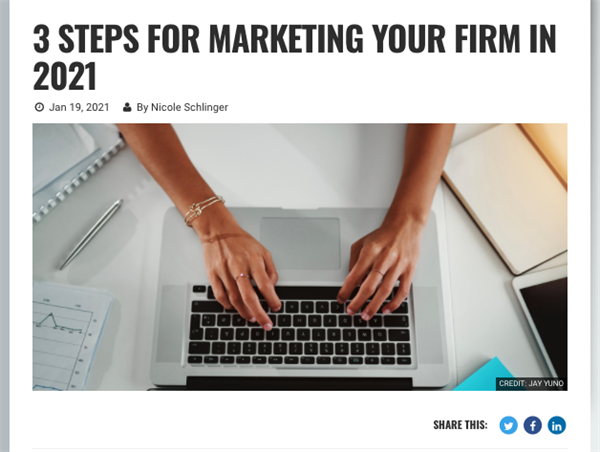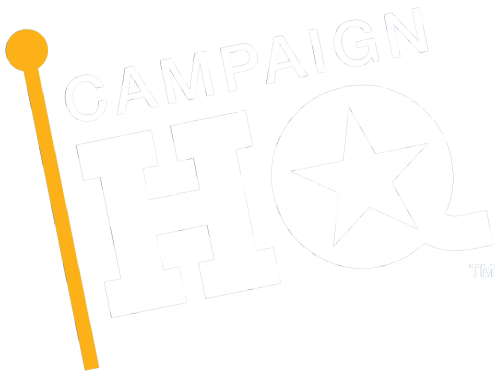- March 29, 2022
- Posted by: Briana
- Category: Blog

The following article about marketing political firm was written by Nicole Schlinger and published by Campaign & Elections here.
Think about where you want your firm to be on Election Night in 2022. How many clients do you have? How many people are on your team? What is your gross revenue?
If you want those dreams to become a reality, the time to start marketing your political firm is now. Unfortunately, many consultants and firm owners are so accustomed to standing in the background, promoting their clients, that they forget to use those techniques to market themselves.
The basic principles of grassroots voter contact apply to any situation in which you want to identify, persuade, and mobilize other human beings. That includes marketing your firm to the people who will benefit most from your services. Here are three ways to start.
Step one: Identify the ideal client for your product or service.
Once you have that ideal client profile nailed down, you can find people, candidates, or firms to match your description. It’s a lot easier hunting when you know what to look for. Think about this like a benchmark poll to determine which voter groups like your candidate based on their background, beliefs, or accomplishments.
Here’s an example: My first business was helping Iowa candidates that couldn’t afford. My ideal clients were viable Republican candidates for Congress and governor in Iowa. Primarily, there were Republican legislative leaders with the potential to build a donor base beyond their district, and willing to use our process.
Having an ideal client profile helps you do more than just make a list. It helps you avoid clients that are outside of your scope, for whom your company is simply not the best choice. For instance, in the example above, you’ll see that we didn’t work for candidates in other states or candidates running for county office. This will help you avoid the time and distraction of serving the wrong client, where you’ll likely come up short anyway.
Remember, you should do more than just download a list of candidates. Capture information about every person with whom you come in contact. Someone who isn’t an ideal client today may become one in the next election cycle. Vendors who provide complementary (non-competitive) products make an ideal referral network.
Now that you have a target universe, it’s time to make sure you have a way to systematically track every interaction you have with them. Ideally, you should start with an inexpensive, ready-made CRM. But if all you can afford is a spreadsheet, that’s fine. Think about this like making sure your voter list is loaded into an appropriate app before your volunteers hit the doors.
Step two: Persuade your audience to use your product or service.
Regardless of your budget, start by making sure you have a marketing appeal that’s compelling to your potential clients. That means focusing on their challenges, rather than your solution. For example, when explaining the benefits of a telephone town hall, at my firm, we talk about giving the candidate a platform to speak with thousands of people, interact with a large audience, and gather useful data. We don’t wax poetic about the software that makes the dialing system work.
Once you have a message worth hearing, apply what you know from the campaign trail to your firm’s marketing. Effective marketing often starts months or even years before your ideal client is ready to buy. Just like your candidate on the campaign trail, you’ll repeat the same message over and over again.
Speaking on an industry panel or being quoted in a local newspaper is a great start. But if the right people don’t hear it, it’s like the proverbial tree falling in the woods. Earned media and even paid sponsorships are only good as your ability to get them in front of the right people. That means building an email list and an audience on social media, so when you’re quoted or featured, the right people hear what you have to say over and over again.
Step three: Turn out your targets, just like in GOTV.
If you’ve identified the right audience of potential ideal clients, shared relevant messages in which they were the hero of the story (and not you), it’s time to move from marketing to closing deals.
While the details of your sales funnel may vary, it ultimately comes down to setting a goal for the appropriate number and quality of personal contacts made each week by you and your team.
We’ve all heard friends and colleagues say they rely on “word of mouth.” Or even worse, they “let their work speak for itself.” Would you ever let a candidate use that as an effective voter contact strategy?
Identify your best potential clients. Persuade them to use your product/service. Close the deal. Now is the time to start using the advice we give to our clients to make headway to marketing political firm in 2022.
